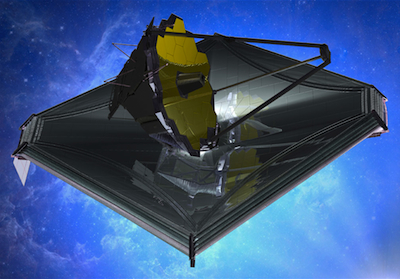ADS Listed Publications
Research Interests
Currently, we understand much of the early Universe, via precision measurements of the cosmic microwave background, and the present-day cosmos, by way of increasingly sensitive telescopes. Connecting the two regimes is one of the biggest problems in astrophysics. However, shedding light on the cosmic Dark Ages is progressively within our reach, primarily because of more and more sophisticated numerical simulations and upcoming observations from missions with a high-z focus, e.g. the James Webb Space Telescope (JWST).

Caption: Artist's impression of the JWST.
Credit: Northrop Grumman (2013).
First Stars and Galaxies
The first stars formed in metal free minihalo environments and were likely to be more massive than modern stars. The first bona fide galaxies appeared later as it took time to accumulate enough matter to be stable against feedback mechanisms.
Computational Astrophysics
Astronomy has benefited immensely from advances in computation and data analysis. I am interested in high performance scientific computing with both compiled and dynamic programming languages.
Theoretical and Observational Cosmology
The past few decades have been heralded as a golden age for cosmology. The ability to accurately measure fluctuations in the cosmic microwave background (CMB) and observe increasingly distant supernova have led to numerous discoveries, including cosmic acceleration due to dark energy.
COLT — Cosmic Lyα Transport code
I developed COLT to simulate Lyα resonant scattering through neutral hydrogen as a probe of the first galaxies (Smith et al. 2015). I plan to release the code repository at some point in the future.